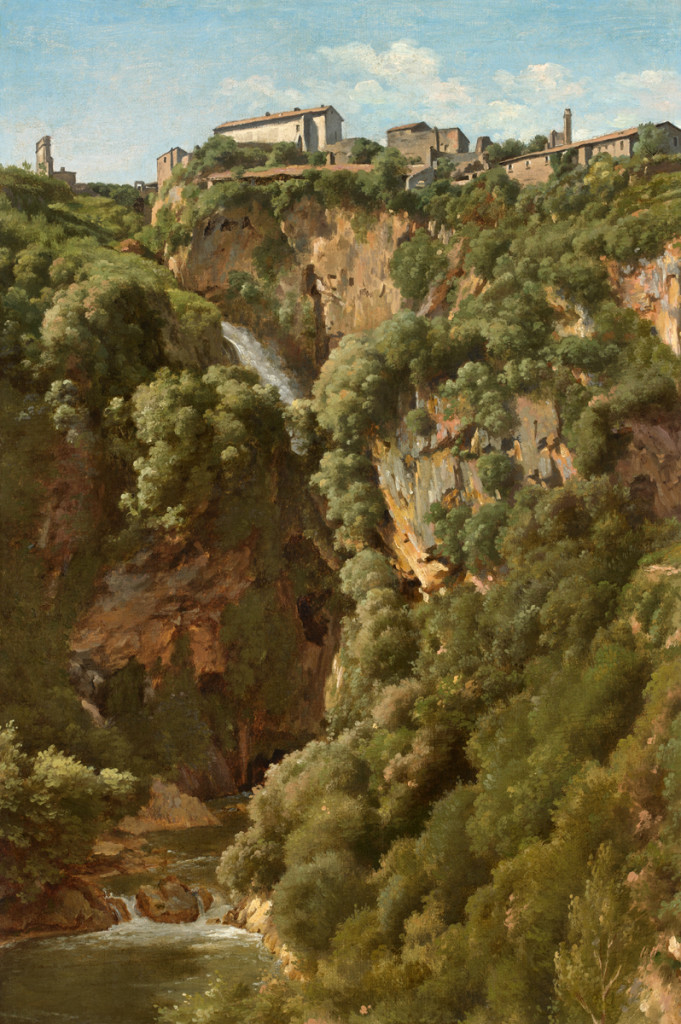Alexandre-François Caminade (Paris 1783 - 1862 Versailles)
The Waterfalls at Tivoli, c.1826-8
Oil on paper laid down on canvas, 47 x 31.5 cm
Provenance:
The artist’s estate
Private collection, France
Alexandre-François Caminade trained under Jacques-Louis David (1748-1825) and Jean-François Léonor Mérimée (1757-1836) in Paris. He won the Paris Academy’s gold medal in 1806 and was awarded a Prix de Rome bursary in 1807. This enabled him to live and work at the Villa Medici in Rome. Although primarily a painter of historical subjects, Caminade took up plein-air landscape painting in Rome. He was almost certainly encouraged in this by the multinational group of young artists working in the city. He prolonged his stay in Rome and in 1825-7 visited the Campagna Romana with Jean-Baptiste-Camille Corot (1796-1875) to make plein-air sketches.
This sheet is a characteristic example of a plein-air oil sketch on paper designed to convey the vibrancy of Mediterranean light. Tivoli’s principal landmark, the famous Temple of Vesta at the upper edge of the waterfalls, was a popular motif among contemporary artists. It is not, however, visible in the present sketch but is located somewhat to the right of Caminade’s viewpoint. He was not interested in focusing on one of the main landmarks on the Grand Tour but there is no doubt that his viewpoint was carefully selected. The depiction of natural effects – the subtle variety of textures, the reflection of sunlight on surfaces and the overall impact of light and shade on rock, scrub and water – clearly gripped his interest. His colouristic orchestration of the landscape is masterly.
Similarities to Corot’s early plein-air sketches executed in the years 1826-8 are clearly visible.[1] The consciously painterly, rather than draughtsmanlike approach dominates in the present sketch and is skilfully achieved. Although it is clear that Corot influenced Caminade’s work, it was a two-way relationship. Corot owned a number of Caminade’s sketches and kept them in his possession until his death. They are listed in the records of his estate sale.[2] Caminade, who was forty-three in 1826, had already spent nine years in Rome acquiring experience as a painter when the thirty-year-old Corot visited the city for the first time.
Caminade later appears to have returned to historical subjects – he is known to have received a number of important commissions for history paintings. He succeeded in freeing himself from the influence of his first teacher, David, to establish an autonomous style. In Paris, he went on to forge a career as a painter of historical subjects, both religious and secular. His works are held in museum collections in Amiens, Autun, Avignon, Saint-Étienne, Strasbourg, Troyes and Versailles as well as in a number of churches in Paris.[3]
[1] See Peter Galassi, Corot in Italy: open-air painting and the classical-landscape tradition, New Haven 1991.
[2] Alfred Robaut, L’œuvre de Corot. Histoire de Corot et ses œuvre, IV, Paris 1905, nos. 653-5, p. 257:
- Au lac Majeur, étude, 24 x 32 cm, sold for 20 francs to M. Durand-Ruel;
- Restes d’aquéducs, campagne de Rome, 24 x 45 cm;
- Étude à Rome, 19 x 34 cm, sold for 21 francs to M. Vandame.
[3] For details of Caminade’s biography, see K. G. Saur, Künstlerlexikon, XV, Leipzig 1997; Les années romantiques. La peinture française de 1815-50, exhib. cat., Nantes, Musée des Beaux-Arts; Paris, Galeries nationales du Grand Palais; and Piacenza, Palazzo Gotico, Paris 1995, p. 343.

